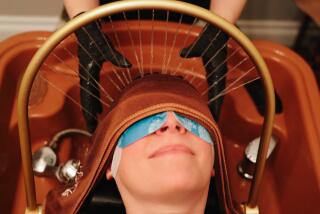HIGH LIFE : A WEEKLY FORUM FOR HIGH SCHOOL STUDENTS : What Shampoos Do and Don’t for the Dead Stuff on Your Head
- Share via
“Imponderables are questions that cannot be answered by numbers or measurements or standard reference books,” writes David Feldman in his introduction to his book “Imponderables.”
“They are the kinds of questions that haunt you for hours . . . until you forget about them before you ever find their solutions.”
Such questions as: “Why do some shampoos direct the user to apply them once? Why do some shampoos direct the user to repeat the application?”
Feldman’s reply: “Hair is dead. A good shampoo can make your hair more manageable, but it can’t make your hair less dead. Any advertisement that claims a shampoo can nourish or revitalize your hair is, in effect, promising to feed and raise the dead.
“The reason we need to wash hair is to eliminate dirt and grease. Every strand of hair is contained in a pore, the hair follicle, which extends well below the scalp. Every hair follicle also has a sebaceous gland, which manufactures an oil, sebum, to moisten the hair follicle, which in turn lubricates the hair and the skin on the surface of the scalp. Although oil is portrayed as the nasty villain on shampoo commercials, sebum prevents your skin and hair from having the dry and brittle consistency that plagues many elderly people. But sebum also collects bacteria and dirt.
“The main purpose of shampoo is to eliminate excess oil and dirt that collect on the surface of the scalp. When shampoo hits the grease, it emulsifies the oil, turning fat globules into small droplets so that the oil and accompanying dirt will rinse out easily. No shampoo is capable of penetrating below the scalp. Shampoos merely collect and get rid of the material on the scalp and hair.
“It is obviously in the interest of shampoo manufacturers to encourage buyers to shampoo every day, using two applications. A few decades ago, most people washed their hair every week or so, and a considerable number used their bath soap to do it. They didn’t have many problems because excess oils don’t accumulate that fast on most scalps. Although some companies recommend applying their product twice each time, the same shampoo will work admirably with only one application, for most people, if used on a daily or every-other-day basis.
“The nice thing about deciding which shampoo to use and how often to use it is that the decision is almost entirely inconsequential. Regardless of what your hairdresser tells you (or tries to sell you), no over-the-counter shampoo is going to wreck your hair. And none will make it beautiful.”
In Cecil Adams’ column, “The Straight Dope,” which has appeared in alternative newspapers since 1973, he answered the following letter:
What’s the truth about protein shampoo? Is there any scientific basis for the claims made about the stuff? What do real experts say you should wash your hair with?
“All shampoos--regular old supermarket brands, home-formulated concoctions and lemon-protein-herb products--have one thing in common: they end up on the far side of your bathtub drain,” Adams wrote. “It’s simply not possible for a shampoo to take stuff out of your hair (dirt and oil) and put stuff in your hair (protein and conditioners) at the same time. The fancy products may leave a nice smell, but that’s all they leave. Even a protein conditioner--which you leave on your head--will help little more than any other type of conditioner. Your hair is made up of dead tissue, and no amount of protein, vitamins, minerals, or seasonings is going to make it live again. In addition, the protein derivative (not a protein at all, you see) used in shampoos bears no resemblance to the protein (keratin) that made your hair.
“So what do you do? Use a shampoo that contains the right amount of detergent for you.”






